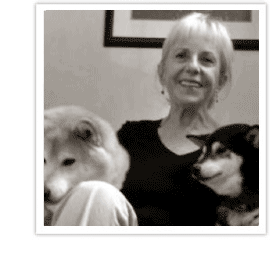
Paula Sallmen was a cherished hospice nurse for 12 years at the bedside of many dying patients to whom she offered end-of-life, compassionate care called “hospice.” Human hospice has been a well-respected, well-recognized type of care for people facing their end-of-life since the early 1970’s.
Yet in all these years of Paula’s service, there was never such compassionate care as hospice extended to animals. It was through a profound experience with one of Paula’s patients named Perry whose dog, Luddy, inspired the idea of treating animals at their end of life the way we treat humans.
Luddy, named after Perry’s favorite composer, Ludwig Von Beethoven, inspired the idea of supporting terminally ill pets the way we support humans, linking pain and symptom control with compassionate care and the necessary psycho/social/spiritual support to those who love them,
Luddy was allowed on the chairs and sofa in the living room but never, ever on the bed. When his owner became bedbound and close to dying, Luddy remained on the floor beside the bed, guarding and supporting Perry.
In Perry’s last days, as he became unresponsive, Paula was aware that his time was limited. Yet, it was Luddy who signaled the alert one day. While Paula was in the bedroom assessing Perry, all of a sudden, Luddy stood up, tilted his head, looked at Perry, and jumped on the “forbidden” bed, lying right next to Perry.
Paula understands the depth of the human-animal bond and knew Luddie was signaling that Perry was about to die, and quickly brought Perry’s wife Helen into the room to witness Perry’s last breath with Luddy by his side. After leaving Helen and Luddy to comfort each other in their shared loss of Perry, Paula sat in the parking lot remembering how many dogs and cats she witnessed being present and comforting their dying human on hospice status.
It was so moving to watch the power of Luddy’s bond that prompted him to break the rule of “not on the bed,” demonstrating how deep and unmistakable the animal and human bond is.
This awareness inspired her to think, “With all that love and bond with human beings, there should be a peaceful passing for pets, too, where humans can be there to offer their pet the same unconditional love and support at the end of their life through compassionate end of life care called Animal Hospice!”
And that is how this nonprofit Peaceful Passing for Pets was named, inspired by Luddy.
The mission of Peaceful Passing for Pets is to fill this void and change the way veterinary medicine will lovingly provide end-of-life care.
Mission Statement
The mission behind Peaceful Passing for Pets is for all pet owners and pets to have the option of home pet hospice. Please read our full mission, vision, and goals on this website to learn more about what home hospice is and the services we offer.
Peaceful Passing for Pets is a groundbreaking model that will change not only the healing, peaceful ways that humans will assist pets in transitioning, but Peaceful Passing for Pets will profoundly change the face of veterinary care and the anticipatory grief journey of pet parents as well as the grieving process following a pet’s death.
The unique case management model incorporates a whole team and plan of care in collaboration and partnership with veterinarians and clinics who partner with Peaceful Passing for Pets, thus filling the void and allowing the full scope of the philosophy and service of home hospice care.

